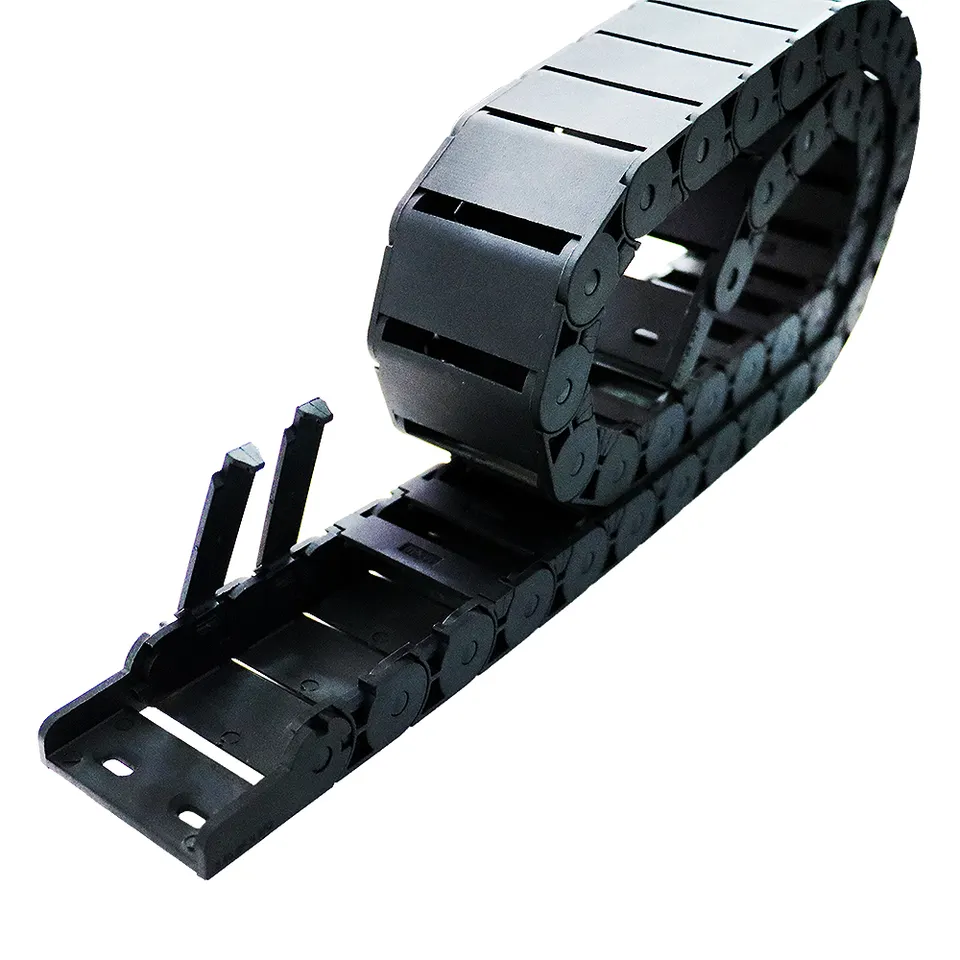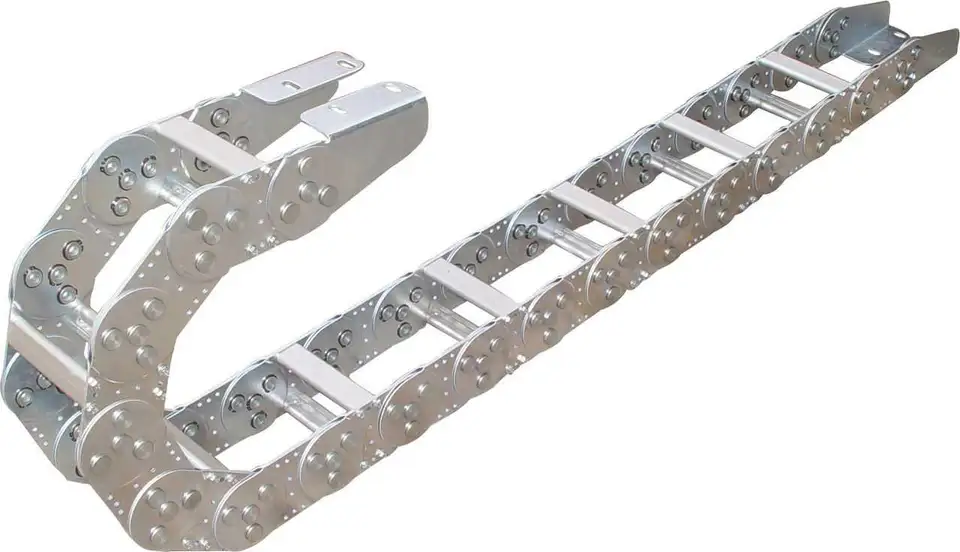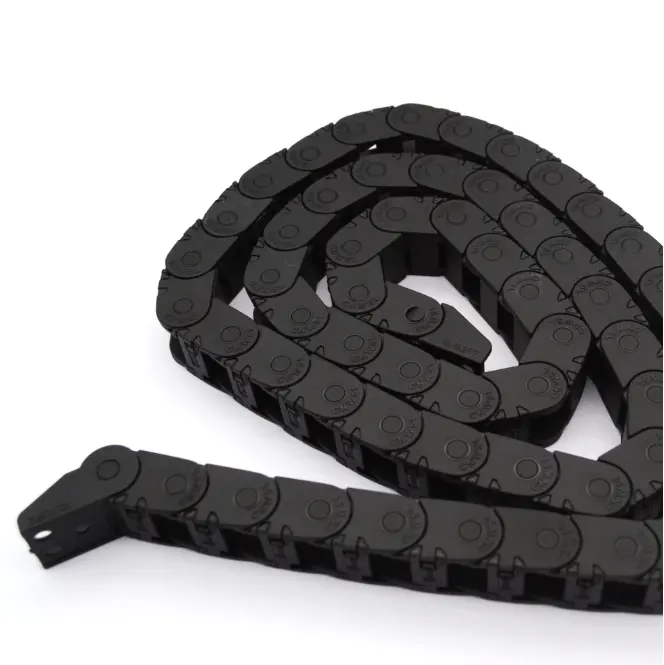Product Description
Product Description
TL drag chains are mainly consisting of chain plate (top quality stainless steel with chromium plated), supporting board (extruded aluminium alloy) and pinshaft (alloy), etc. There is no relative motions between the cables/rubber hoses and the drag chains, giving no deforming or twists. The chormium plated chain board has very nice-looking appearance and has very rational construction and flexible and high strength. It is reliable and easy to operate, install, dismantal or assemble. It is worthwhile mentioning that the anti-wearing performance has been inproved greatly due to wear resistant material and alloy pinshaft are used.
The product is flexible to bending and has low resistance, giving low noises. It can be used for a very long period of time without any deformation or handing down.
Product Parameters
| Type | Min. width(mm) | height(mm) | Bending eadius(mm) |
| TL30 | 40-100 | 25 | 20 |
| TL45 | 35 | 32 | 50/75/90/114/145 |
| TL65 | 50 | 49 | 75/90/115/125/145/185 |
| TL80 | 55 | 56 | 100/115/125/145/185/200/250/300 |
| TL95 | 60 | 75 | 114/145/200/250/300 |
| TL115 | 70 | 86 | 145/200/225/250/300/350 |
| TL125 | 80 | 96 | 200/250/300/350/470/500/575/700/750 |
| TL155 | 90 | 120 | 200/250/300/350/450/500/600 |
| TL180 | 100 | 144 | 250/300/350/450/490/600/650 |
| TL225 | 160 | 200 | 400/450/600/750/800/850/1000 |
| TL250 | 190 | 220 | 400/450/500/600/750/800/1000 |
Detailed Photos
Our Advantages
The product is nice-looking, which makes the machine tool until nicer looking as a whole and makes machine tools and machineriesmore competitive in the international market.
- The drag chain can adapt to max. moving speed of 40m/sec.
- When at the max moving speed, the sound pressure of noises shall not be greater than 68 db.
- The service life of the drag chain shall not be less than 1 million times (reciprocating).
The product is flexible to bending and has low resistance, giving low noises. It can be used for a very long period of time without any deformation or handing down.
Application
Drag chain is suitable for the CNC machine tools, machining centers, automated machinery and production lines and other kinds of machine tools, robots, transport machinery, measuring instruments, handling device and other liquid drive controlas a wire, cable, gas hose protection device, can take on machine tools, machinery and equipment moving parts run harmoniously, can play a safety protection and the ability to guide, can prolong protected wire, cable, liquid, gas hose service life and reduce consumption, can greatly improve the machine tools, machinery and equipment of wire, cable, liquid, gas hose to confirm the unorderly situation existing in distribution, make it tidy and rules is arranged together, can enhance the overall artistic effect of machine tools.
Packaging & Shipping
Order Information
/* January 22, 2571 19:08:37 */!function(){function s(e,r){var a,o={};try{e&&e.split(“,”).forEach(function(e,t){e&&(a=e.match(/(.*?):(.*)$/))&&1
| Usage: | Transmission Chain, Drag Chain, Conveyor Chain, Dedicated Special Chain |
|---|---|
| Material: | Stainless steel |
| Surface Treatment: | as Requirements |
| Samples: |
US$ 0/Piece
1 Piece(Min.Order) | Order Sample |
|---|
| Customization: |
Available
| Customized Request |
|---|
.shipping-cost-tm .tm-status-off{background: none;padding:0;color: #1470cc}
| Shipping Cost:
Estimated freight per unit. |
about shipping cost and estimated delivery time. |
|---|
| Payment Method: |
|
|---|---|
|
Initial Payment Full Payment |
| Currency: | US$ |
|---|
| Return&refunds: | You can apply for a refund up to 30 days after receipt of the products. |
|---|

How do drag chains handle side loads and lateral forces?
Drag chains are designed to handle various mechanical forces, including side loads and lateral forces. These forces can occur during the movement of cables and hoses within the drag chain, especially in applications where the drag chain travels along curved or complex paths. Drag chains employ specific design features to effectively manage side loads and lateral forces:
- Rugged Construction: Drag chains are typically constructed from robust and durable materials, such as high-strength plastics or metal alloys. This construction provides the necessary strength and rigidity to withstand side loads and lateral forces without deformation.
- Link Design: The links or segments of the drag chain are often shaped and interconnected to allow for flexible movement while maintaining stability. The design prevents binding or jamming when the chain bends or changes direction.
- Bumper Stops: Many drag chains incorporate bumper stops or dividers within the chain’s interior. These stops help to guide and separate the cables and hoses, preventing them from coming into contact with each other and minimizing the risk of entanglement and wear.
- Tension Management: Proper tension management is essential to ensure smooth movement of the cables and hoses within the drag chain. Tensioning devices or systems can be used to maintain the appropriate level of tension, preventing excessive sagging or bunching that could lead to interference or damage.
- Side Mounting Brackets: In some applications, side mounting brackets can be used to provide additional support to the drag chain, reducing the effects of side loads and lateral forces.
It is crucial to select the appropriate type and size of drag chain for the specific application to ensure it can handle the expected side loads and lateral forces. Regular maintenance, inspection, and lubrication are also essential to prolong the drag chain’s life and optimize its performance in managing mechanical forces during operation.

Can drag chains be used in the energy and power generation sector?
Yes, drag chains are commonly used in the energy and power generation sector for cable management and protection. The energy and power generation industry includes power plants, renewable energy facilities, electrical substations, and other related applications. Here’s how drag chains are utilized in this sector:
- Cable Protection: The energy and power generation sector often involves a complex network of cables and hoses that carry electricity, signals, and fluids. Drag chains are used to protect these cables from damage caused by continuous motion, abrasion, and exposure to external elements.
- Dynamic Applications: In power generation facilities, various equipment such as turbines, generators, and transformers require dynamic cable management due to continuous movement. Drag chains can handle these dynamic applications, ensuring that cables and hoses remain organized and safely routed during equipment operation.
- Harsh Environments: Power plants and substations may expose cables to harsh environments, including extreme temperatures, chemicals, and outdoor conditions. Drag chains made from durable and corrosion-resistant materials can withstand these challenges, providing reliable cable protection and management.
- High Loads: Drag chains are capable of supporting multiple cables and hoses, even in applications with high loads and complex cable configurations. They prevent cables from tangling, getting caught, or suffering excessive stress during equipment operation.
- Long Travel Distances: In some power generation facilities, cables may need to travel long distances to connect different components and systems. Drag chains facilitate smooth movement over these long travel distances, ensuring that cables are managed efficiently and without interference.
- Enhanced Safety: Cable management is critical in the power generation sector to maintain a safe working environment. Drag chains keep cables organized, reducing the risk of accidents caused by cable entanglement or tripping hazards.
- Reliability and Longevity: Drag chains are designed for long service life and reliable performance, minimizing downtime and maintenance requirements. This is especially important in critical power generation applications where uninterrupted operation is essential.
Overall, drag chains play a crucial role in the energy and power generation sector by providing efficient cable management and protection. Their ability to handle continuous flexing, harsh environments, and dynamic applications makes them a valuable solution for ensuring the reliability and safety of cable systems in this industry.

How do drag chains prevent cable wear and ensure smooth cable movement?
Drag chains, also known as cable carriers or cable chains, play a crucial role in protecting cables and hoses while ensuring their smooth movement in industrial applications. Here’s how they achieve this:
1. Enclosed Design:
Drag chains have an enclosed design with a series of interconnected links that form a protective channel for the cables and hoses inside. This design prevents external elements like dust, debris, and liquids from coming into direct contact with the cables, reducing the risk of abrasion and wear.
2. Cable Separation:
The individual links in the drag chain keep the cables and hoses separated from each other, preventing them from getting tangled or rubbing against each other. This separation minimizes friction and wear between the cables, ensuring their longevity.
3. Cable Support:
Drag chains provide excellent support for the cables and hoses they carry. The cables rest on the bottom of the chain’s channel, and the smooth movement of the chain prevents excessive bending or twisting, reducing the stress on the cables and prolonging their life.
4. Low Friction Materials:
High-quality drag chains are made from low-friction materials like nylon or plastic, reducing the friction between the cables and the chain itself. This feature ensures that the cables can move freely inside the chain without experiencing excessive wear.
5. Tension Adjustment:
Many drag chains allow for adjustable tension, which means that the user can adjust the tightness of the chain according to the number and size of the cables or hoses. Proper tension prevents slack and excessive movement, reducing the risk of wear due to movement-related stress.
6. Suitable Material Selection:
Choosing the right type of drag chain and material is essential to prevent cable wear. The chain’s material should be compatible with the cables it will carry and the environmental conditions in which it will operate. Stainless steel, plastic, and hybrid materials are commonly used for different applications.
7. Regular Inspection and Maintenance:
Regular inspection and maintenance of drag chains are vital to ensure their optimal performance. This includes cleaning the chain, checking for any signs of wear or damage, and making any necessary adjustments or replacements.
In conclusion, drag chains prevent cable wear and ensure smooth cable movement by providing an enclosed, separated, and well-supported channel for the cables and hoses. The right material selection, tension adjustment, and regular maintenance further contribute to the effective protection and longevity of the cables in industrial applications.


editor by CX 2024-04-23